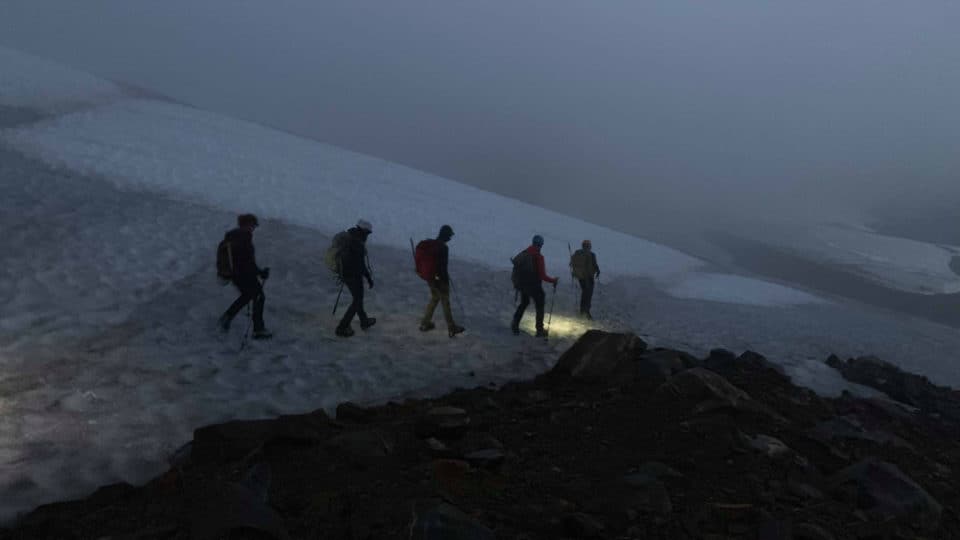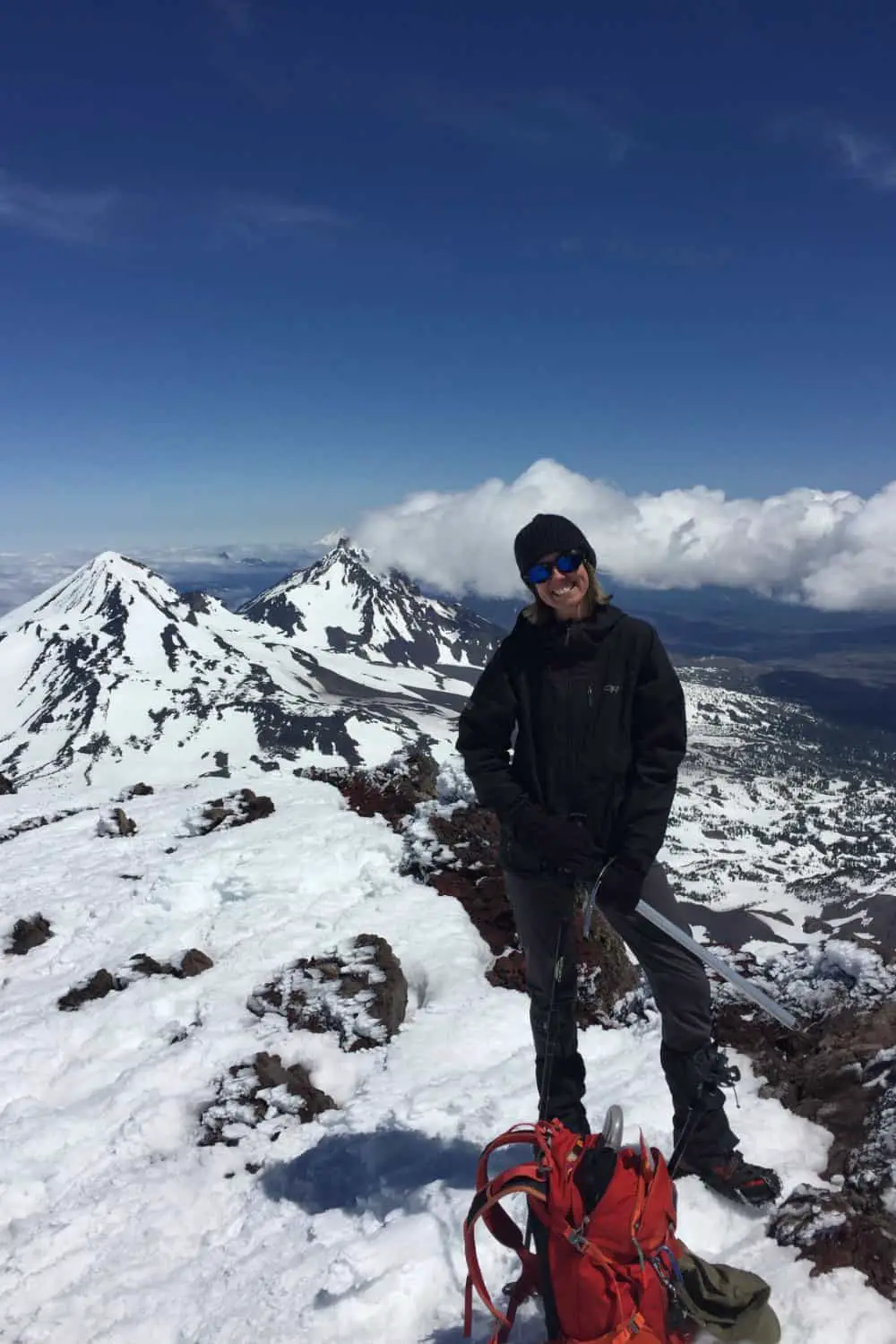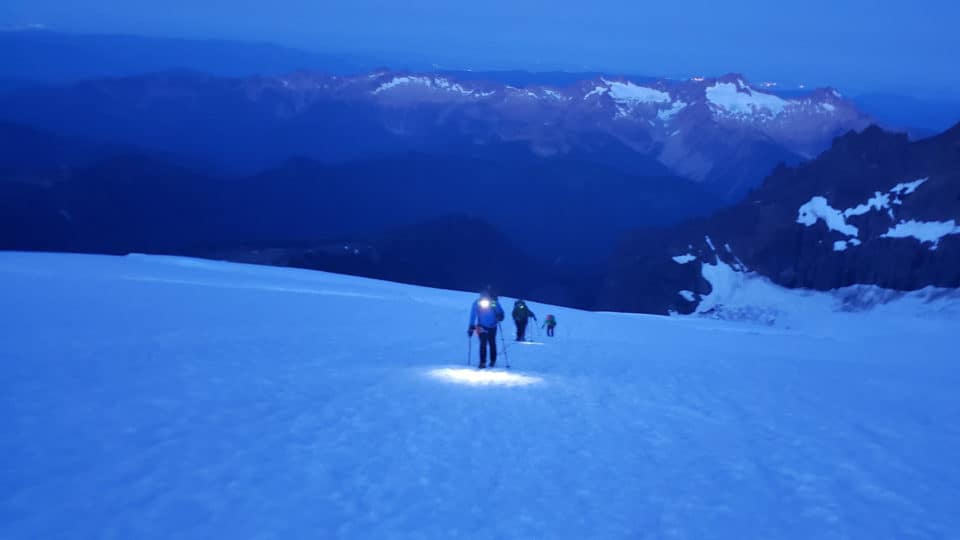We’ve all had level-up moments in our hiking careers. When you buy your first pair of spikes, when you realize a ten mile day doesn’t feel all that long, when you start using the word “bivy.” Even your first solo hike can feel like a big step if you’ve only gone with people, and beginning to hike with a group can signify a huge shift in an introvert’s trajectory. For me, coming home from REI one winter’s night with an ice axe and crampons was a huge level-up. Getting mountaineering boots. My first volcano. A real backpack.
When I think about what these things give us, the level-up gear items, it’s opportunity that comes to mind, accompanied by the image of greatly oversized double-doors opening, or the hand of God gesturing invitingly toward some alpenglowing eastern Sierra-like mountain ranges with a sweeping motion as if to say, here, go, it’s all yours.
The headlamp, as small and simple as it may be, has given me the biggest rewards and the best gifts, and allowed me to do things I never could have done otherwise.
Longer Days, More Miles
Once upon a time I sat in my car in the Mount Si parking lot waiting for it to get just a little bit lighter out so I could start hiking. I knew headlamps existed, I just thought of them as something other people wore, the Everest people, real mountaineers, surgeons, scuba divers maybe, but not me. Over that spring and summer, my hiking days were about equal in number to my non-hiking days as I set about checking off every hike in my local hiking guidebooks. And then fall hit, and with it the darkness: here in the PNW, we have 16 hours between sunrise and sunset during the summer solstice, but that means in the depth of winter we only have eight hours of daylight. I was easily doing (and loving) 10-12 hour days, and was getting faster, covering first 18 then 20 then 24 miles a day, but I was finishing in near-darkness more often and getting nervous. I’ve always been a little afraid of the dark, and being in the woods in the dark multiplies that fear by like a million. Enter the headlamp and I can start earlier, go later, and increase my mileage. New goals started forming, new worlds opened up, it was a feeling of expansiveness and wide open spaces as time constraints were lifted and I thought of all the times I grumbled about there not being enough hours in the day: now there were plenty.
Handsfree Illumination
It’s not that you can’t set up camp, put crampons on, or rifle through your pack by flashlight, but why would you want to? A flashlight adds extra weight, you have more batteries to worry about, and at best you’re having to tripod the poor thing somewhere where it points at what you’re doing, at worst you have to hold it and try to do whatever it is with one hand. Take the phone analogy (handsfree vs. not) and think about the freedom it gives us to multitask to our heart’s content. To walk in the dark and use both poles, take photos, eat or drink while walking … the idea of holding a flashlight becomes unthinkable.
Handling Emergencies and Unexpected Plan Changes
Some emergencies are actual emergencies: a broken bone, dehydration, concussion, AMS, etc. But most of the emergencies that most of us will experience are simply unexpected plan changes. Even the day 24 of us got stuck at the Mount Townsend parking lot due to cars stuck on the narrow icy exit road, even that was just inconvenient. Sure, it wasn’t in anyone’s plans to be there five extra hours, but no one was dying from it either, and we could have easily walked out to the town eleven miles away if we had to, but we didn’t have to. It was completely unexpected and unplanned for but it wasn’t a true emergency.
A headlamp could be the difference between panic and confidence if you’ve gotten off-route and the sun is getting lower in the sky with an unsettling quickness, and you know that using your cell phone flashlight will kill the battery, and your paper map is getting harder to read, and you know you’re getting close to rejoining the trail but you also know that once you do it’s still three miles to the parking lot and you only have about a half-mile of daylight left. One item has potentially saved the night from ending badly.
Having a headlamp with me at all times makes me feel like I could handle a delay and make those extra miles in the dark safe. The deadline-anxiety as you keep taking mental note of the sun’s position fades; of course you’re aware of the light, you always are. But if it gets dark before you get back, it’s not the end of the world. If someone needs to stop and redo blister tape, if someone trips and needs to bandage their knee, if someone rolls an ankle and needs to ice it in a cold stream for a few minutes: none of these things become dealbreakers in and of themselves because you aren’t under the gun to get back before dark.
Also, a headlamp can prevent an emergency from happening in the first place, since you’ll be able to see tripping hazards, avoid sheer drop-offs, and navigate water crossings.
Beat The Crowds
Here’s the other fun thing about hiking pre-dawn or post-twilight: You can do the popular hikes without being inundated with families and dogs and music and toddlers and dates and meetup groups. You can feel remote and wild, even on trails fairly close to urban areas. If you’re one of those that goes to the mountains for solitude and silence, here’s your ticket in.
Sunrise, Sunset

If you’re someone who goes to the mountains for the Milky Way and moonlight and loves feeling the eerie beauty of the night forest, you don’t need to wait until you’re on a camping trip to see the stars scattered across the sky like diamond chips thrown onto a black velvet jeweler’s cloth. Hike under the smallest sliver of a moon to the top of a peak with a 360° view and sit and wait as the sky lightens first to a deep electric blue, then gold at the horizon, eventually going through all the sherbet pinks and oranges until the crisp blue of a cloudless morning takes over and you descend, feeling like you’ve just been to a private showing by an artist too sophisticated for mainstream consumption. Conversely, hike after work and stay at the summit for sunset–and stay long after others are scurrying down, stay while the reds and oranges disappear to indigo, and stay as long as you want, not until you have to go. There is something so incredibly intimate and personal and magical about nighttime in the mountains that it’s a shame to only know them in daylight.
Hiking At Night: No Limits
The biggest thing getting a headlamp did for me was added about a zillion new objectives to my to-do list, because now I could go anywhere and not be limited by daylight or distance:
- Circumambulated Mt. St. Helens in a day
- Climbed Mt. Whitney in a day
- Climbed Mt. Adams in a day
- Climbed Mt. Stuart in a day
- Did the through-hike of the Enchantments (a twenty-ish mile trail normally done as a backpacking trip but the lottery on those permits is hard to win, so option B is to day hike it) in a day
- I would hot have been able to summit Glacier Peak, Mt. Baker, or Mt. Rainier without a headlamp as these were two day climbs that involved setting out for the summit not long after midnight
- Mt. Hood and South Sister were both doable during daylight hours but starting before sunrise allowed for firmer, safer, more easily traveled snow
And those are just the big-name ones. I unlocked countless other trails and peaks and experiences with the addition of that one piece of gear, countless moments, beautiful, life-changing moments, moments that I’m thinking about as I write this and imagining my life without them, and I don’t know who I’d be today without the things they’ve given me.
Best Headlamps For Women
I started out with a cheap sporting goods store headlamp that took a couple AA batteries and could shine regular or red or green light, but also weighed several ounces more than necessary and always ran out of juice after like a hour and a half. When my kids and I went down to the Ape Caves at Mt. St. Helens, my oldest flipped on her Petzl Actik Core and my head quickly turned in her direction and I was like, okay I need that what is that? Its 450 lumens shone so so many times brighter than mine, like the difference between being on a dark road with no headlights, or with highbeams. It lit up the inside of that cave like it was daylight. I bought one the day after we got home.
Petzl Actik Core 450
Aside from the robust amount of light it produces, the Petzl Actik Core lasts for over a hundred hours on a single charge (yes, you read that correctly), weighs next to nothing, and has a rechargeable battery as well as being able to run on three AAAs. It’s comfy on your head, slides into any helmet clips (or can be mounted to a helmet), and comes with a USB cord for charging which I use in my phone charger. The red setting allows folks to stand close like on a trail or in camp and talk and not blind each other, and the white is bright enough on its lowest setting to get dressed, affix crampons, read maps, etc. But back to that charging time! Two hours on massive high beams, seven on medium, and folks have reported up to 130 on low.
Features:
- Comes with the Core USB-rechargeable battery (charge time via USB port: 3 hrs.) and is also compatible with 3 AAA/LR03 batteries (not included) without the need for an adapter
- Features 2 beam patterns (flood or mixed) and several white brightness levels; single-button adjustment allows for quick and easy lighting selection
- Red lighting preserves night vision; reflective headband provides low-light visibility
- Lock function helps you avoid turning it on during transit or storage
- Headband is detachable and washable
- CE-certified; IPX4 rating means this can withstand splashing water from any angle
- Compatible mounting accessories (not included) allow the lamp to be attached to any kind of helmet or to a bicycle
[amazon box=”B07TXSYQP6″ template=”horizontal”]
For progressively decreasing prices, you can get the 350 or 250 lumen models, but I can’t think of a reason to buy any headlamp other than the 450. There is virtually no situation it can’t handle, But if you’d like to shop around, the Petzl has stiff competition:
Black Diamond Spot 350
- This latest version of the Black Diamond Spot 350 headlamp features a more compact design, updated user interface and improved multifaceted optical lens design that saves battery
- Track battery life with updated, 6-setting 3 LED battery meter
- Emits up to 350 lumens on max power setting
- PowerTap™ Technology allows instant brightness adjustment settings between full and dimmed power
- Brightness Memory allows you to turn the light on and off at a chosen brightness without having to revert back to full or medium power
- Settings in full strength with proximity and distance modes, dimming, strobe, red night-vision and digital lock mode
- Compact, low-profile design uses 3 AAA batteries (included)
- Rated IPX8: waterproof-tested to operate at least 1.1 m underwater for 30 min.
- If submerged, water may enter the battery compartment and it will still operate; be sure to dry it out completely after use in wet conditions
[amazon box=”B08BHYNX8Q” template=”horizontal”]
BioLite HeadLamp 200
- Minimalist design features headband-like construction that wicks moisture and dries fast; integrated electronics allow for better balance and a bounce-free fit
- Comes in fun colors
- Great for runners
- Provides 200 lumens across 4 lighting modes: White Spot (dimmable), White Strobe, Red Flood (Dimmable) and Red Strobe
- Ultralight construction weighs only 1.75 oz. (50g)
- USB rechargeable; no need for alkaline battery replacements
- IPX4 rating means this can withstand splashing water from any angle
[amazon box=”B07T25LMYB” template=”horizontal”]
Sources
Petzl: Website
Black Diamond: Website
BioLite: Website

Wendy Harrington is a California native who has lived in a small town at the foothills of the Cascade Mountains in Washington state since 2001. Her love of trail running and peakbagging has led her to summit all five Washington volcanoes, climb to the high points of three states, and put nearly a thousand miles a year on her boots. Her loves include ridgelines, saddles, granite, one-day pushes on big mountains, anything volcanic, long solo days, and objectives that push limits and test endurance.

